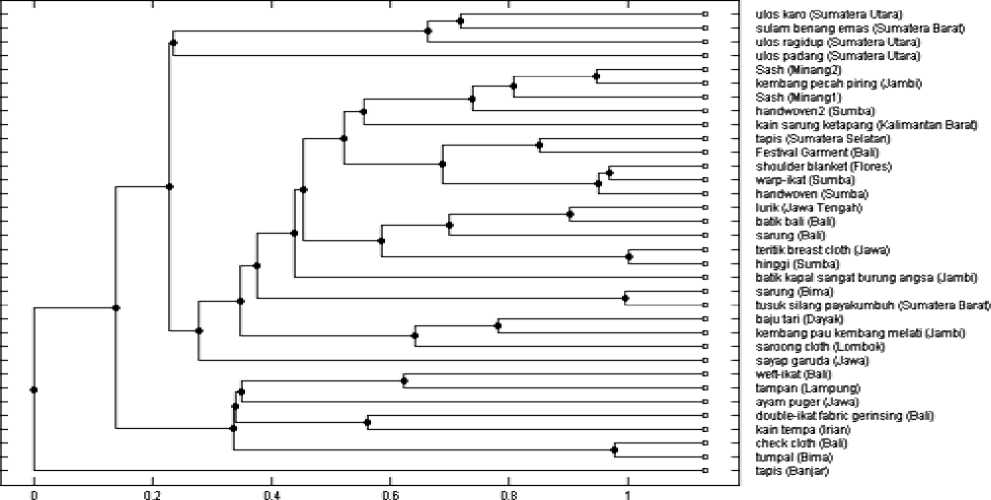each other production modus, e.g.: sarung from Bima (eastern Indonesia) and tusuk silang from
Payakumbuh West Sumatra.

nrrr*jiwE dts1aκes
Figure 4
Phylomemetic Tree of Several Indonesian textile ornamentation.
Other interesting facts about the phylomemetic tree on textile handicrafts are also shown in the
specific tree of Javanese batik. The calculated fractal dimensions and color histogram analysis in
their roles as variables filling the memeplex vectors has brought the clustering of batik products in
the sense of their respective locations. The batik crafted in keraton (Javanese classical palaces)
traditions, e.g.: Yogyakarta, Surakarta, grouped in different clusters with those produced by crafters
in coastal tradition, e.g.: Lasem, Pekalongan, Semarang. This explains that the different
anthropological aspects of the culture between the two traditional crafting processes and
techniques as well as the existing and culturally emerged aesthetical tastes. However, some
particular things can also be read from the visualization regarding to the similar general processes of
mbatik between those traditional work of arts, batik. Kelelawar (bat) motif, for instance, is made in
the coastal tradition (Lasem), but yet clustered closely enough with some motifs from Surakarta
(Solo Keraton). This is interesting and simultaneously showing that from the pictures depicted in
batik still has some “familial” crafting principles and of course the familial of Javanese whether they
live in the palace’s surrounding or in coastal areas.
Evolutionary speaking, the similar cognitive capacity and interactions with foreigner has changed the
way of appreciation of (visual) aesthetics which in turn affected the creation of batik patterns. The
phylomemetic tree of batik in some ways could bring us to the conjecture of further explanation of
the different characters of the Javanese people living in the coast-side and in the rural. From here,
anthropological works on human culture and history could meet and excite the further discussion of
the evolution of culture. This is the right track for memetics is meant to be a tool explaining the
diversity of culture related to various aspects of human life, acquisition of information, and cognitive
capacity in the sense of evolutionary method and principles.
More intriguing information
1. Inhimillinen pääoma ja palkat Suomessa: Paluu perusmalliin2. Economic Evaluation of Positron Emission Tomography (PET) in Non Small Cell Lung Cancer (NSCLC), CHERE Working Paper 2007/6
3. The name is absent
4. Density Estimation and Combination under Model Ambiguity
5. The name is absent
6. The name is absent
7. TOWARD CULTURAL ONCOLOGY: THE EVOLUTIONARY INFORMATION DYNAMICS OF CANCER
8. Plasmid-Encoded Multidrug Resistance of Salmonella typhi and some Enteric Bacteria in and around Kolkata, India: A Preliminary Study
9. The Integration Order of Vector Autoregressive Processes
10. The Shepherd Sinfonia